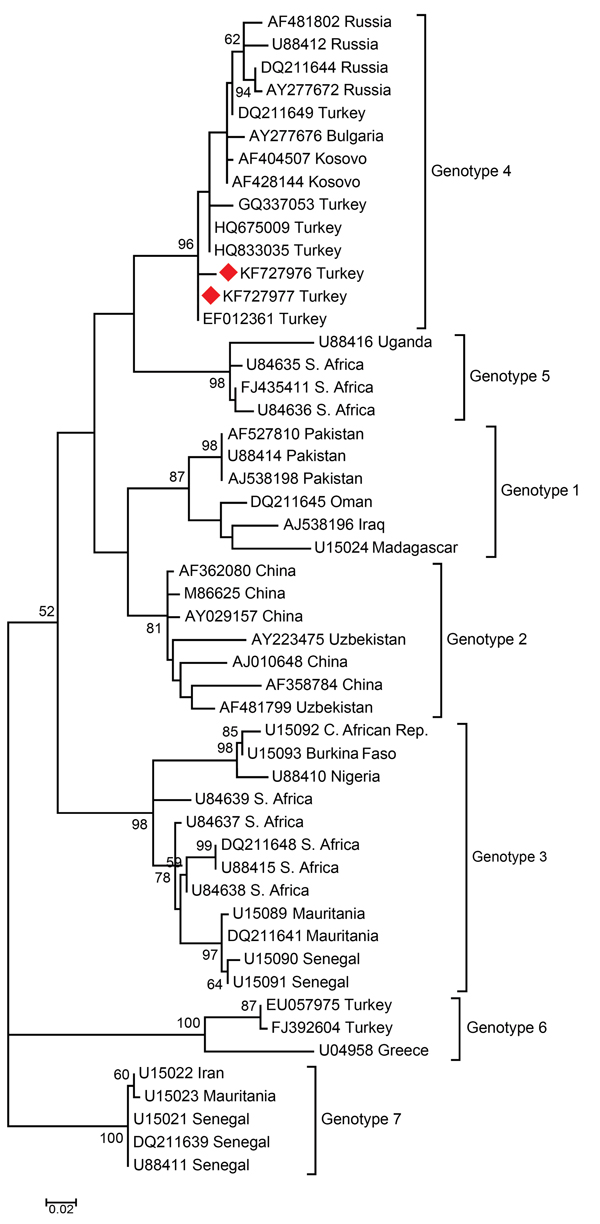Volume 20, Number 8—August 2014
Dispatch
Role of Migratory Birds in Spreading Crimean-Congo Hemorrhagic Fever, Turkey
Figure 1

Figure 1. Phylogenetic tree of nucleotide sequences of CCHFVPhylogenetic tree based on the 260 bp of the small segment of the CCHFV genomeThe multiple sequence alignment was obtained by using MEGA 5.1 (http://www.megasoftware.net), and the phylogenetic tree was constructed by the maximum-likelihood method using 1,000 bootstrap replicates of the sequence dataThe tree is drawn to scale with branch length in the same unit as those of the evolutionary distance used to infer the phylogenetic treeThe phylogenetic tree includes the 7 genotypes described by Mild et al(8)Bootstrap confidence limits (>50) are shown at each nodeThe geographic origin is given for each sequenceThe CCHFV Samsun Turkey described in this report is shown by the diamondScale bar indicates number of nucleotide substitutions per siteCCHFV, Crimean-Congo hemorrhagic fever; S., South; C., Central.
References
- Leblebicioglu H. Crimean-Congo haemorrhagic fever in Eurasia. Int J Antimicrob Agents. 2010;36(Suppl 1):S43–6 and. DOIPubMedGoogle Scholar
- Uyar Y, Christova I, Papa A. Current situation of Crimean Congo hemorrhagic fever (CCHF) in Anatolia and Balkan Peninsula. Turk Hij Deney Biyol Derg. 2011;68:139–51. DOIGoogle Scholar
- Shirihai H, Kirwan GM, Yosef R. Raptor migration in Israel and the Middle East: a summary of 30 years of field research. Eilat (Israel): International Birding & Research Center in Eliat; 2000.
- Bariş S, Erciyas K, Gürsoy A, Özsemir C, Nowakowski J. Cernek—a new bird ringing station in Turkey. Ring. 2005;27:113–20.
- Walker AR, Bouattour A, Camicas J-L, Estrada-Peña A, Horak IG, Latif AA, Ticks of domestic animals in Africa: a guide to identification of species. Edinburgh (Scotland): Bioscience Reports; 2003.
- Yapar M, Aydogan H, Pahsa A, Besirbellioglu BA, Bodur H, Basustaoglu AC, Rapid and quantitative detection of Crimean-Congo hemorrhagic fever virus by one-step real-time reverse transcriptase–PCR. Jpn J Infect Dis. 2005;58:358–62 .PubMedGoogle Scholar
- Schwarz TF, Nsanze H, Longson M, Nitschko H, Gilch S, Shurie H, Polymerase chain reaction for diagnosis and identification of distinct variants of Crimean-Congo hemorrhagic fever virus in the United Arab Emirates. Am J Trop Med Hyg. 1996;55:190–6 .PubMedGoogle Scholar
- Mild M, Simon M, Albert J, Mirazimi A. Towards an understanding of the migration of Crimean-Congo hemorrhagic fever virus. J Gen Virol. 2010;91:199–207 and. DOIPubMedGoogle Scholar
- Alerstam T, Christie DA. Bird migration. Cambridge (UK): Cambridge University Press; 1993.
- Tekin S, Bursali A, Mutluay N, Keskin A, Dundar E. Crimean-Congo hemorrhagic fever virus in various ixodid tick species from a highly endemic area. Vet Parasitol. 2012;186:546–52 and. DOIPubMedGoogle Scholar
- Albayrak H, Ozan E, Kurt M. Molecular detection of Crimean-Congo haemorrhagic fever virus (CCHFV) but not West Nile virus (WNV) in hard ticks from provinces in northern Turkey. Zoonoses Public Health. 2010;57:e156–60 and. DOIPubMedGoogle Scholar
- Zeller HG, Cornet JP, Camicas JL. Crimean-Congo haemorrhagic fever virus infection in birds: field investigations in Senegal. Res Virol. 1994;145:105–9 and. DOIPubMedGoogle Scholar
- Lindeborg M, Barboutis C, Ehrenborg C, Fransson T, Jaenson TG, Lindgren PE, Migratory birds, ticks, and Crimean-Congo hemorrhagic fever virus. Emerg Infect Dis. 2012;18:2095–7 and. DOIPubMedGoogle Scholar
- Palomar AM, Portillo A, Santibanez P, Mazuelas D, Arizaga J, Crespo A, Crimean-Congo hemorrhagic fever virus in ticks from migratory birds, Morocco. Emerg Infect Dis. 2013;19:260–3 and. DOIPubMedGoogle Scholar
- Tsiodras S, Kelesidis T, Kelesidis I, Bauchinger U, Falagas ME. Human infections associated with wild birds. J Infect. 2008;56:83–98 and. DOIPubMedGoogle Scholar